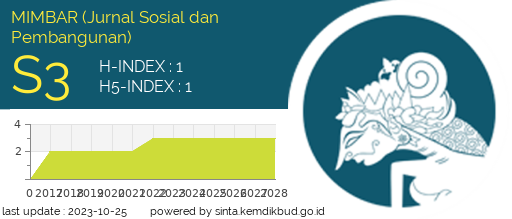Legal Review Of Liability From Deepfake Artificial Intelligence That Contains Pornography
DOI:
https://doi.org/10.29313/mimbar.v39i2.2965Keywords:
Artificial Intelligence, Deep Fake, PornographyAbstract
This article seeks to determine who is responsible for the widespread use of deepfake AI to create pornographic content and how Indonesian law governs it. Deepfakes, a subfield of artificial intelligence, can manipulate visual media by superimposing facial features on the bodies of others, creating misleading videos. Deepfakes were first used in movies and then in gadgets. However, deepfakes have been used to make explicit pornographic videos. This research is normative law-based. This study found that Indonesia has no specific legislation on artificial intelligence technology, except for Law Number 19 of 2016, which amends Law Number 11 of 2008 on Electronic Information and Transactions. Number 44 of 2008 on Pornography prohibits pornographic content creation and provides criminal penalties to hold offenders accountable. In Government Regulation (PP) Number 71 of 2019, which regulates electronic systems and transactions, pornographic platform providers cannot use deepfake technology.
References
Ahmed, Saifuddin, Wei Ting Ng, Sheryl, Wei Ting Bee, Adeline. (2023). Understanding the role of fear of missing out and deficient self-regulation in sharing of deepfakes on social media: Evidence from eight countries. Front Psychol. 2023; 14. https://doi.org/10.3389/fpsyg.2023.1127507
Agus Syihabudin, Asep Wawan Jatnika, Alamta Singarimbun, Shohib Khoiri. (2019). The Development of Information Technology Applications of Religious Charity Through Humanities Technology Approach. MIMBAR Jurnal Sosial dan Pembanugnan, Vol. 35 No. 2, https://doi.org/10.29313/mimbar.v35i2.4885.
Asikin, Z. (2016). Pengantar metode penelitian hukum. Rajawali Pers.
Bachtiar, E., Duwila, A. A., Chaerul, M., Affandy, N. A., Makbul, R., Tanjung, R., Purba, B., Saidah, H., Sutrisno, E., & Sari, M. (2021). Pengetahuan Kebencanaan dan Lingkungan. Yayasan Kita Menulis. https://doi.org/10.59141/jiss.v3i08.661
Dwityas, N. A. (2016). Komunikasi dan Pariwisata: Peran User Generated Content Bagi Traveler dalam Media Sosial. Jurnal Simbolika, Volume 2, 4. https://doi.org/10.31289/simbollika.v2i1.224
Edison H Manurung. (2019). Peran Hukum dan Tantangan Penegak Hukum dalam Menghadapi Era Revolusi Industri 4.0. Jurnal Penelitian Hukum, Volume 1, 129. http://ojs.mputantular.ac.id/index.php/sj/article/view/354/276
Efendi, Y. (2018). Internet of Things (IOT) sistem pengendalian lampu menggunakan Raspberry PI berbasis mobile. Jurnal Ilmiah Ilmu Komputer Fakultas Ilmu Komputer Universitas Al Asyariah Mandar, 4(1), 19–26. https://doi.org/10.35329/jiik.v4i1.48
Faathurrahman, M. Faqih, Soerjati, Enni. (2022). Pengaturan Pertanggungjawaban Pelaku Penyalahgunaan Deepfakes Dalam Teknologi Kecerdasan Buatan Pada Konten Pornografi Berdasarkan Hukum Positif Indonesia. Jurnal Indonesia Sosial Teknologi, Vol. 3, 11. http://dx.doi.org/10.36418/jist.v3i11.528
G, W. S. dan E. (2016). Membuat Term & Conditions. https://usahasosial.com/wpcontent/uploads/2016/06/membuat_terms_conditions_2016JunWed00183445310.pdf.
Hudini, T. (2017). Teknologi Informasi dan Komunikasi Bagi Mahasiswa dalam Pemanfaatan Diplomasi Digital: Nasional dan Internasional. Faktor Exacta, 10(2), 172–182. https://doi.org/10.30998/faktorexacta.v10i2.1305
Istiarni, A., & Kurniasari, E. (2020). Peran Perpustakaan Digital Dalam Menciptakan Ruang Publik (Studi Kasus Perpustakaan Digital Universitas Lampung). Fihris: Jurnal Ilmu Perpustakaan Dan Informasi, 15(1), 31–53. https://doi.org/10.14421/fhrs.2020.151.31-53
Khusna, I. H., & Pangestuti, S. (2019). Deepfake, Tantangan Baru Untuk Netizen (Deepfake, A New Challenge For Netizen). Promedia (Public Relation Dan Media Komunikasi), 5(2). https://doi.org/10.52447/promedia.v5i2.2300
Kurnia, M. A. A. . & A. (2021). Aspek Hukum Internasional Dalam Pemanfaatan Deepfake Technology Terhadap Perlindungan Data Pribadi. Volume 2, 48.
Lisa Adhrianti, Indah Septirisani, Neneng Cucu Marlina. (2022). Communication Patterns of Cybercrime in The Financial Technology Business During The Covid-19 Pandemic. MIMBAR Jurnal Sosial dan Pembanugnan, Vol. 38 No. 2, https:// https://doi.org/10.29313/mimbar.v0i0.10077.
Lubis, M. S. Y. (2021). Implementasi Artificial Intelligence Pada System Manufaktur Terpadu. Seminar Nasional Teknik (SEMNASTEK) UISU, 4(1), 1–7. https://jurnal.uisu.ac.id/index.php/semnastek/article/view/4134
Muchtar, M. A. dan H. N. (2018). Cyberlaw: Perlindungan Hukum Bagi Orang Terkenal dari Cybersquatting. Logoz Publishing.
Novi, A. (2019). Internet of Things dan Kecerdasan Buatan Pengenalan, Penerapan dan Studi Kasus Industri. CV. Tampuniak Mustika Edukarya. http://repository.unas.ac.id/2269/1/buku pertama upload.pdf
Riantrisnanto, R. (2020). Pamer Hasil Analisa Video Mirip Gisel, Roy Suryo Minta Waspada Deepfake. https://www.liputan6.com/showbiz/read/4403933/pamer-hasil-analisa-video-mirip-gisel-roy-suryo-minta-waspada-deepfake
Schwartz, O. (2018). You thought fake news was bad? Deep fakes are where truth goes to die. Guardian. https://www.theguardian.com/technology/2018/nov/12/deep-fakes-fake-news-truth
Struensee, S.V. (2021). Analyzing Dilemmas Posed by Artificial Intelligence and 4IR Technologies Requires using all Available Models, Including the Existing International Human Rights Framework and Principles of AI Ethics. SSRN Electronic Journal June 25, 2021. https://papers.ssrn.com/sol3/papers.cfm?abstract_id=3874279
Suseno, S. (2012). Yurisdiksi Tindak Pidana Siber. Refika Aditama.
Tantri, A. H., Riyadi, M. A. F., & Wanabil, N. (2022). Pemanfaatan Kecerdasan Buatan Dalam Kegiatan Pengabdian Masyarakat di Indonesia: Sebuah Tinjauan Pustaka Sistematis. Notasi, 1(2), 21–28. https://journal.kallabs.ac.id/index.php/home/article/view/25
Downloads
Published
Issue
Section
License
Copyright (c) 2023 MIMBAR : Jurnal Sosial dan Pembangunan

This work is licensed under a Creative Commons Attribution-NonCommercial-ShareAlike 4.0 International License.














